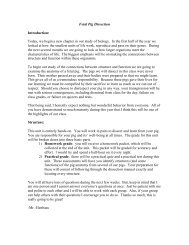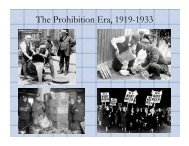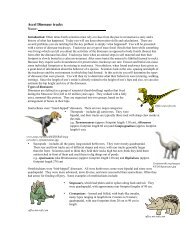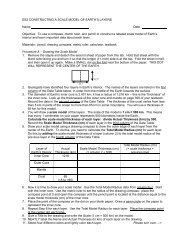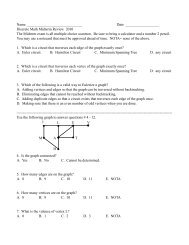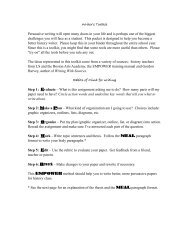Abraham Maslow
Abraham Maslow
Abraham Maslow
Create successful ePaper yourself
Turn your PDF publications into a flip-book with our unique Google optimized e-Paper software.
<strong>Abraham</strong> <strong>Maslow</strong>:<br />
An American Humanistic<br />
Psychologist<br />
A presentation by<br />
May Soliman, Jenny Lee, Marissa Wiegel, and Zak Baumer
What was <strong>Abraham</strong> <strong>Maslow</strong>’s<br />
background like?<br />
<strong>Maslow</strong> was born April 1, 1908 in Brooklyn, New York.<br />
<strong>Maslow</strong> was the first of seven children born to the<br />
Jewish couple who immigrated from Russia.<br />
<strong>Abraham</strong> went to college to study law in order to<br />
please his parents. He then went on to marry Bertha<br />
Goodman against his parents wishes. Bertha and <strong>Abraham</strong><br />
had two daughters.<br />
The couple moved to Wisconsin so that <strong>Maslow</strong> could<br />
study at the University of Wisconsin. It is there that<br />
he studied under the famous eye of Harry Harlow and<br />
become fascinated by psychology.
What was <strong>Abraham</strong> <strong>Maslow</strong>’s<br />
background like?<br />
--Part II--<br />
<strong>Maslow</strong> obtained his Bachelor’s degree in Psychology in<br />
1930, he then went through higher education and<br />
obtained his PhD in 4 short years.<br />
After he received his PhD, <strong>Maslow</strong> went on to teach at<br />
Brooklyn College.<br />
While <strong>Maslow</strong> taught at Brooklyn, he was appointed the<br />
chair of the Psychology department. While there,<br />
<strong>Maslow</strong> met Kurt Goldstein. Goldstein was the first to<br />
expose <strong>Maslow</strong> to Humanistic Psychology.<br />
<strong>Maslow</strong> then went on to develop his Hierarchy of Needs<br />
in 1954, which he then revised in 1970 to produce the<br />
current hierarchy.<br />
<strong>Maslow</strong> died June 8, 1970 of a heart attack at his home<br />
in California.
<strong>Maslow</strong>’s 1970<br />
Hierarchy of Needs<br />
Self-Actualization<br />
Needs<br />
- Morality,<br />
Creativity<br />
Synthesis<br />
(Justification)<br />
Esteem Needs -<br />
Love/Belonging<br />
Needs<br />
Safety Needs -<br />
Physiological Needs -<br />
-<br />
Self-esteem, Confidence,<br />
Respect of Others<br />
Friendship, Family,<br />
Sexual Intimacy<br />
Security of: Employment,<br />
Morality, Family, Health<br />
Food, Water,<br />
Sleep, Breathing<br />
Antithesis<br />
(Relationships)<br />
Thesis<br />
(Individual)
Key Terms<br />
Psychological - The need to be satisfied first; before everything<br />
else.<br />
Lester shows this need by thinking about himself before he thinks<br />
about his wife or Jane.<br />
Safety - The desire to feel safe no matter what you are doing or where<br />
you are.<br />
Lester exhibits this need by quitting his old job and gets a new one<br />
at a fast food restaurant, where job security is much higher.<br />
Love/Belonging - The desire to feel loved and accepted by the people<br />
around you.<br />
Jane exhibits this when she starts a relationship with Ricky. She is<br />
not concerned about her body-image as much as she was in the<br />
beginning.<br />
Esteem - The need to have high self-esteem and for people around you to<br />
respect you.<br />
Ricky is a good example for he does not care what people around him<br />
think.<br />
Self-Actualization - The desire to use your abilities to “be the best<br />
you can be.”<br />
Lester’s desire to get into shape can be applied to this need.
How Does <strong>Maslow</strong> Believe<br />
Personality Develops?<br />
<strong>Maslow</strong>, a humanistic psychologist, believed<br />
that humans strive to reach the highest levels<br />
of consciousness and wisdom that they can. As<br />
people work their way up <strong>Maslow</strong>’s hierarchy of<br />
needs, their personality develops, until they<br />
reach the self actualization stage, in which<br />
they have reached their potential. When people<br />
are in the self-actualization stage, they may be<br />
labeled as a “fully functioning person” with a<br />
“healthy personality.” <strong>Maslow</strong> explained people’s<br />
personality through his hierarchy of needs.
According to <strong>Maslow</strong>, What is<br />
considered a Healthy Personality?<br />
According to <strong>Maslow</strong>’s theory, for a person have a healthy personality they must<br />
fulfill all (or most) of the levels of the hierarchy of needs starting with the<br />
physiological needs up to the esteem needs. If your lower needs have not been met, you<br />
are not yet ready to fulfill your true potential. At the top of the hierarchy is selfactualization.<br />
But it is not easy to reach this point due to our stressful lives and<br />
demands. According to <strong>Maslow</strong>, only about 1-2% of the world is actually selfactualizing.<br />
<strong>Maslow</strong> researched many famous people including Albert Einstein, <strong>Abraham</strong><br />
Lincoln, and Thomas Jefferson, who he believed to have reached self-actualization. He<br />
then researched them thoroughly and composed a list of qualities that they shared that<br />
include:<br />
Being reality-centered (being able to tell the difference<br />
between what is dishonest and what is genuine)<br />
Enjoy solitude and were content being alone<br />
Enjoy meaningful personal relations with only a few close<br />
friends rather than superficial relationships with many people<br />
Non-hostile sense of humor (rather than poking fun of other<br />
people they made jokes at their expense or more general jokes<br />
about people in general)<br />
Acceptance of self and others<br />
Humility and respect<br />
Strong ethics<br />
Creative and original thoughts
According to <strong>Maslow</strong>, What is<br />
considered an Unhealthy Personality?<br />
<strong>Maslow</strong> believed that all of the needs are instinctual and that every<br />
person strives to fulfill them. An unhealthy person is someone who has not<br />
fulfilled their basic needs. He believed that sometimes society and cultural<br />
norms can stifle our growth. He also believed that low self-esteem and<br />
inferiority complexes were the root of many psychological problems. <strong>Maslow</strong><br />
also believed that people need a set of metaneeds in their lives in order to<br />
be happy (the opposites of these needs would lead to an unhealthy<br />
personality). They include:<br />
Truth, not dishonesty<br />
Uniqueness not than uniformity<br />
Justice and order not injustice and lawlessness<br />
Self-sufficiency not dependency<br />
Meaningfulness not senselessness<br />
Simplicity not unnecessary complexity<br />
Unity not forced choices
Personality Analysis: Angela<br />
Angela Hayes is a perfect example of an unhealthy personality. She appears to be<br />
superficial and promiscuous when in reality she has created her idealized image of herself to<br />
convince others that she isn’t ordinary. According to <strong>Maslow</strong>’s theory, Angela has not<br />
fulfilled all of her needs and is still trying to fulfill her safety needs, as well as many<br />
others.<br />
Angela needs stability and protection as well as a structure and order. She also needs<br />
limits<br />
She doesn’t have strong authoritative parents who set down rules for her and she is<br />
therefore without guidance<br />
She is unable to move to her other needs and is stuck on this level<br />
Angela needs love and a sense of belonging<br />
Even though Angela has friends, she cannot really connect to anyone (the exception of<br />
this is her paternal relationship with Lester at the end of the movie where Lester<br />
acts as a “father figure” to her)<br />
For the majority of the movie she is lonely and has a fear that others will<br />
her as being “ordinary”<br />
Angela needs self-esteem (higher and lower)<br />
Lower self-esteem is the respect of others, the need for a reputation, and<br />
recognition<br />
think of<br />
She has an inferiority complex and creates an idealized image of herself in order<br />
for people to notice her and think of her as unique<br />
Higher self-esteem is self-respect, confidence and independence<br />
She does not love herself and is not really sure who she is because she has been<br />
playing a role her entire life<br />
She does not have confidence in herself and is very insecure
The End
Works Cited<br />
http://wilderdom.com/personality/<br />
L10-2Humanistic.html, 5/9/07: 5/12/07<br />
http://honolulu.hawaii.edu/intranet/<br />
committees/FacDevCom/guidebk/teachtip/<br />
maslow.htm, 5/11/07: 5/12/07<br />
http://webspace.ship.edu/cgboer/<br />
maslow.html, 5/12/07: 5/12/07<br />
http://en.wikipedia.org/wiki/<br />
<strong>Abraham</strong>_<strong>Maslow</strong>, 5/10/07: 5/12/07



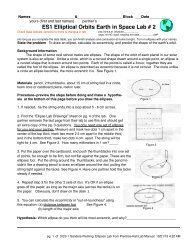


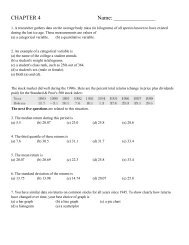


![';1asAu ro; las I sgeo8 leuo!]eslanuol aql utelqo o1 palenttouJ ue I ...](https://img.yumpu.com/49072782/1/190x221/1asau-ro-las-i-sgeo8-leuoeslanuol-aql-utelqo-o1-palenttouj-ue-i-.jpg?quality=85)

